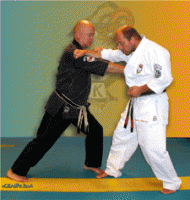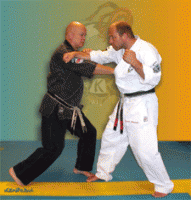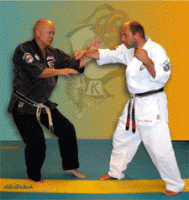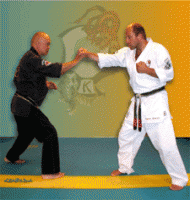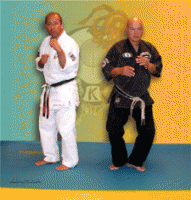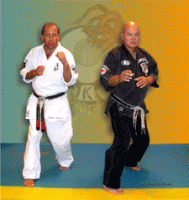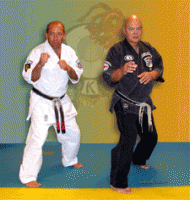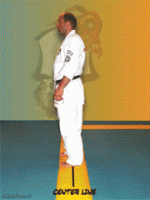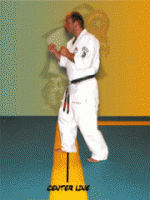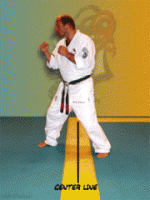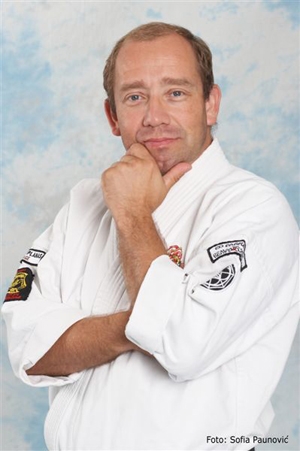Proper footwork is the key in any art
By: Ingmar Johansson
Photo and artwork done by: Johnny Hansen Kenpo.DK
To become really good in any art you have to know and show “Economy of Motion” and in the category of footwork means removing from your footwork all extra or unnecessary moves. When I used to train boxing they used to say if you want to become the best boxer in the world the key is footwork. In the art we have many different ways to move from one point to another. Most of them are related to depth of travelling. There are many different martial arts and many vary from each other in there footwork. This article could analyze all the maneuvers found or used in Kenpo. But I feel that they are very well explained in Mr Parker’s books. Therefore I would like to discuss “Economy of Motion” involved in the footwork and the common errors done by many and the reasons for them in our art.
Basics
Mr Planas says as a teacher, or when teaching, all you correct in a student is improper or bad basics. A problem he sees in many students is poor or weak basics. Remember all we do is basics which are all any system does. In Kenpo terminology basics are any single move like a stance, kick, block, punch etc. We combine these basics to make up our techniques. So it is easy to understand or see that when you make corrections in a student’s motion or techniques it is just correcting basics. Which brings to mind the saying that weak basics equal weak techniques – strong basics equals strong techniques. One has to understand the importance of proper footwork which brings out the maximum effect of the three power principles we use in Kenpo – meaning torque, back-up mass and marriage of gravity as well as proper timing.
Common mistakes
A great way to study the footwork is in the forms. Here the student is under no pressure from an opponent so here we can examine his movements. Students sometimes have a tendency to move the foot more then one time to obtain the desired position. If the students are not taught the basics correctly from the beginning they will usually have the extra steps, move, or moves without realizing it. This equals adding time to your motion or moves. To make corrections in basic footwork long after a student has been doing the art is much harder then teaching him correctly from the beginning. As it has become habit which takes much more thought and work on the student’s part. Breaking the heel or lifting the heel of the rear foot moving in reverse from a forward bow is another very common basics problem. When this is done you are actually delaying your reverse motion on beat. By staying in place or moving forward slightly before you retreat or move back. The proper way to do this should be thought in the early stage of the students training which is found in the “Long Form One”. Floating is also a common beginner basics problem it adds distance and time and also robs power in many techniques like when floating or going up by straitening your supporting leg when delivering a kick on a downward angle like in the last kick in the technique “Dance of Death” if you have learned the complete technique.
Breaking the heel
Switching
Everything in Kenpo basics is defined around the left and right or front or back. There are two different ways of thinking when defining switching, which by definition means changing sides facing the opponent without losing or gaining distance. You can talk or think about which foot you move or in which direction you move to keep it as simple as possible which is the way most things are explained or laid out in Kenpo. For example in every stance you have a front foot and a back foot. A right neutral bow is called right because the front foot is the right meaning the closest foot to the opponent.
Therefore when you say front to back the simple way to think is move your front foot to the back foot and then move your back foot to the front. To make it longer in explanation you can think of the direction you move. Now when you say back to front means taking your front foot to the back and then move your back foot to the front. No matter which way you do it there should not be more then two moves. And this leads us to another common problem when not using the economy of motion principle. Students often do slight or little adjustment steps to set the neutral base or stance,
which really means you are actually doing three moves and not two by adding another “and then”. Switching and shuffles utilize the same timing principle of reverse or opposite and then eliminate the “and then”. To eliminate the “and then” and make the move as fast as possible brings in the hop or jump switch. Meaning that as you move the front foot to the rear the rear foot is moving to the front at the same time. And therefore there is no “and then”.
Switching
Shuffling
Shuffling is gauging distance and is not considered part of a technique as it goes where it’s needed to make the technique work. When shuffling you can step and then drag or you can drag and then step, in either case we have the “and then”. The “Push-Drag” eliminates the “and then” which means both feet’s should move together or at the same time. Making it one move where as the “Step-Drag” and “Drag-Step” are two moves. Many people just do a fast “Step-Drag” and think they are doing a “Push-Drag”. No matter how fast this is done it is still two moves. Which still has the “and then”.
Splitting
Splitting is another common error. Once again remember there is a time and place for everything as you can split your stance is certain techniques but its rarely used. Therefore when we say rule we mean 99% or most of the time. The problem with splitting is that you don’t gain or lose any distance which would change the opponents focus point. In which he gauged his footwork for in the first place.
That means you have done moves that actually kept you in the same place or focus point of your opponent. Students do this and it is a common mistake. As you can see in the photos I move back with the left foot from my center line and then I move the right leg forward from the center line and as you can see my body is still over the center line or starting point. You could also split by moving the right foot forward first and then step back with the left foot. A third variation would be hopping with both feet at the same time. These timing relationships are exactly the same as the “Switches” used in Kenpo. Either way you don’t gain or lose ground. Learn where and when it’s ok to do splitting and the reasoning why.
Splitting
Solutions
One of many ways to fix these errors is to train one basic isolated or only a few basic moves at a time in slow motion. You should try to find the feeling of proper body mechanics and feel that the moves is comfortable and makes sense. As instructor it is our job to teach and make students realize the importance of strong basics and it’s our job to make him train or drill it frequently. As we know students don’t like to do basics all the time Mr Planas use the analogy of the reason a boxer hires a trainer. The trainer makes the boxer do his basics over and over again because he will usually not do this on his own.
The art is built like a pyramid upside down. Meaning that we don’t eliminate things we have learned but add to them. Where the top of the pyramid is the foundation meaning we put down one block and then stack more blocks on top etc. On this base we use the rest of our knowledge as building blocks. To build a normal pyramid you have to eliminate building blocks to get to a single block on the top. In Kenpo we never eliminate or discard things we learn, but keep them and add to them. Use at least 30% of your training time to go through and practice your basics. There are things to remember like ”You can lead a horse to the water but you can’t make him drink” another Chinese saying is ”A mistake uncorrected is twice made”. Meaning the horse has to want the water. And one has to want to fix these mistakes or he will keep making them.
Ingmar Johansson
Athletics consultant
5:th degree black belt
Head instructor for Ed Parker´s Kenpo Karate in Sweden.


